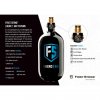They will be accepted if the bottle checker recognises the standard.
e.g. By default a bottle checker in the U.K. will look for the Pi gate symbol and the date, if they see DOT/TC then they start to get defensive assuming it's an imported US cylinder but should look a bit more closely in case the cylinder really is tri standard and has Pi as well - and even if Pi hasn't been found to have another look for HSE in case it's an older (but still valid / tested UK cylinder)
(Noting that some people have been put off by seeing USA in the markings, which is irrelevant to the standard that it's built to and market its built for)
Not every bottle checker will allow a uk user to use an aluminium cylinder for 10 years, and it could be rejected at 6 years even though it's uk legal
The same may go for 13ci cylinders which are legal to use forever without the need for testing
With regard to overdoing hydro tests, as long as the cylinder passes the appropriate test and the standard allows then it's good to go. Eg you could assume a standard fibre will be tested twice in its lifetime, but if people are cautious about having dropped a cylinder or having bought a second hand one then they may submit it for extra tests and it gets 4 or 5 within the 15 year life
The hydro test for each standard sets criteria which is revealed to the tester in the markings
If it has an REE number then that is the permitted expansion capacity
The PW and PH figures in the markings give the working pressurne and the maximum pressure in Bar
Eg:
Aluminium PW207 PH310 = 3002psi 4496psi
Fibre PW310bar PH466bar = 4496psi 6758psi
They mean that you can use an aluminium to 3000 psi and a fibre to 4500 psi (though the 310bar figure realy converts to 4496psi)
And the higher PH figure is the maximum that it should be capable of holding without failure
The hydro tester will pressurize with water whilst measuring how much it expands (as marked by REE or in accordance with the appropriate standards test)
If it expands no more then permitted then it's a pass (along with all the other visual checks etc - noting that they can fail in the first visual without proceeding to test)
If it expands more than permitted it fails










